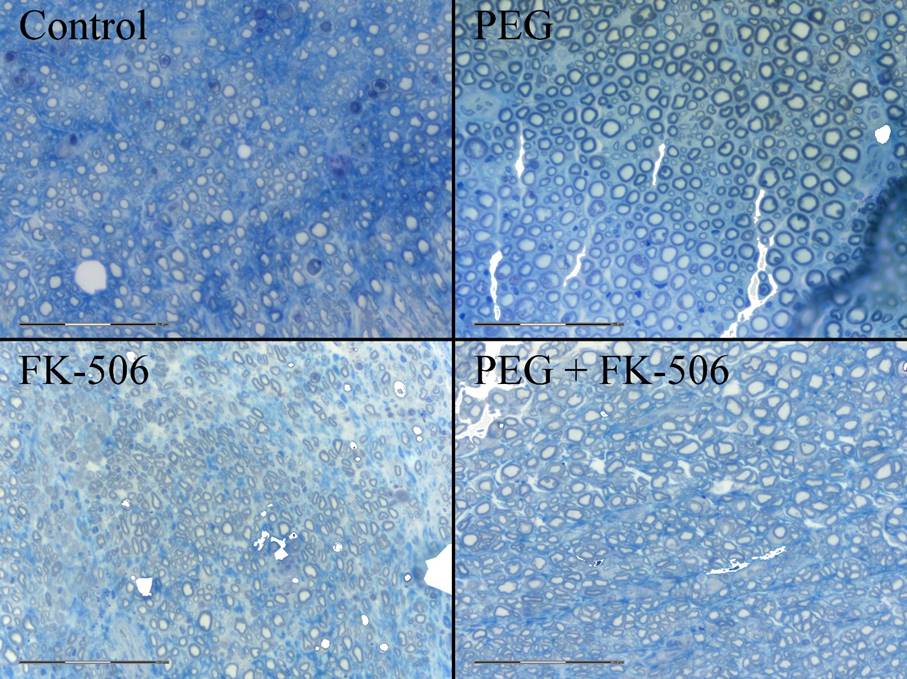Polyethylene Glycol and FK-506 in Nerve Injury Treatment
Adriana M. Paskal, MD1,2; Wiktor Paskal, MD1,2; Piotr Pietruski, MD, PhD3,4; Zofia Kusmierczyk, PharmD2; Ewa Jankowska - Steifer, PhD5; Jaroslaw Andrychowski, MD, PhD6; Pawel K. Wlodarski, MD, PhD1
1Department of Research Methodology, Laboratory of Center for Preclinical Research, Medical University of Warsaw, Warsaw, Poland, 2Department of Experimental and Clinical Physiology, Laboratory of Center for Preclinical Research, Medical University of Warsaw, Warsaw, Poland, 3Department of Plastic and Reconstructive Surgery, Center of Postgraduate Medical Education, Prof. W. Orlowski Memorial Hospital, Warsaw, Poland, 4Department of Applied Pharmacy and Bioengineering, Medical University of Warsaw, Warsaw, Poland, 5Department of Histology and Embryology, Laboratory of Center for Preclinical Research, Medical University of Warsaw, Warsaw, Poland, 6Department of Neurology and Neurosurgery, Faculty of Medical Sciences, University of Warmia and Mazury in Olsztyn, Olsztyn, Poland
Introduction
Peripheral nerve injury causes distal nerve stump degeneration and impairment of nerve function. Polyethylene glycol (PEG) induces axolemmal fusion of proximal and distal nerve stump axons. PEG therapy inhibits degeneration and leads to rapid recovery of nerve function. PEG treatment has not yet been compared with any other treatment with confirmed neuroregeneration enhancing impact. FK-506 is an immunosuppressive drug with reported pro-neuroregenerative potential in nerve injury models. The aim of this study was to compare the neuroregenerative effects of PEG treatment and preinjury FK-506 administration in a rat model of sciatic nerve transection injury.
Materials & Methods
28 male SPRD rats divided into 4 groups underwent unilateral sciatic nerve transection with primary suture - based repair. Group A (control group) received placebo injections. Group B received placebo injections and PEG treatment. Group C received FK-506 injections. Group D received both FK-506 injections and PEG treatment. Functional outcomes were assessed using the sciatic functional index and prick test. Nerve specimens were harvested for histomorphometric analysis 12 weeks after the initial surgery.
Results
Histomorphometric analysis (Fig. 1) showed increased neuroregeneration in all groups receiving treatment (higher G Ratio) compared with the control (p < 0.001). Group D (PEG + FK-506) had better results: higher mean axon area, G Ratio (p < 0.001), perimeter and axon count (p > 0.05) than other groups. Myelin sheath parameters in group D correlated with remyelination process characteristics. PEG treatment (groups B and D) effected in the improved sciatic functional index during the first postoperative week although results were not significant compared with groups A and C. All treated groups had better mean prick test scores than the control (p > 0.05) at study endpoint.
Conclusions
According to histomorphometric analysis, polyethylene glycol combined with FK-506 results in superior neuroregeneration outcomes when compared with simple suture-based nerve repair (control), PEG or FK-506 separately.
Figure 1. Histology slides from distal nerve section sites of the four groups: A – Control, B – PEG, C – FK-506, D – PEG + FK-506.
Back to 2019 Abstracts
